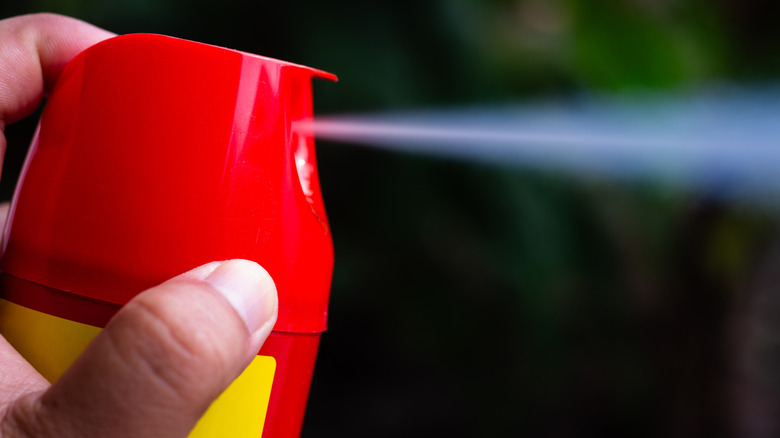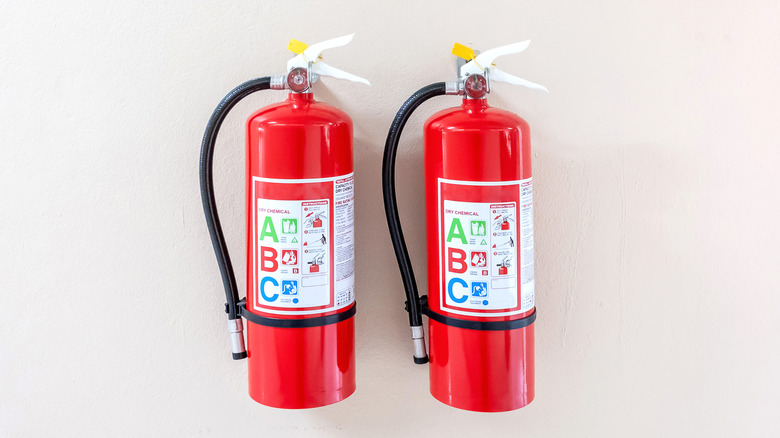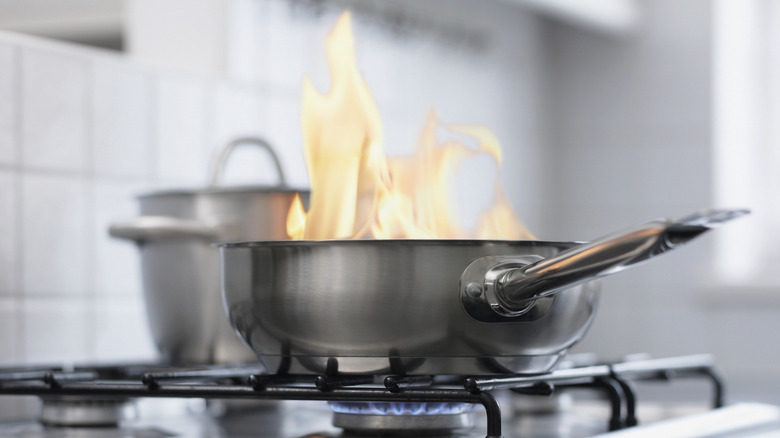Do Aerosol Fire Suppressant Cans Have Downsides Or Should They Be A Home Essential?
A fire extinguisher is one of those emergency supplies every house should have — no exceptions. Depending on your home layout, you might even need more than one fire extinguisher for your home. They can be bulky and a bit tricky to store, which has led to the invention of an alternative: aerosol fire suppressant cans. These cans are the size of a can of shaving cream and claim to be able to do everything a full-sized fire extinguisher can. The truth, though, is that they have some major downsides — and may not be the best choice for most households.
Several brands make aerosol fire suppressants, including First Alert, StaySafe, and Prepared Hero. In addition to being smaller and easier to store than traditional fire extinguishers, they're comparatively easy to handle; just press the dispenser button. They also claim to have other benefits — for example, the brand First Alert says its product has a longer-lasting spray than a regular fire extinguisher, and the brand StaySafe claims that its version can put out all types of fires, including grease fires. If you're looking for an easy fire safety solution, it's easy to get sucked into these claims.
Fire safety, though, is about far more than convenience, and one should not rely on these products to keep one's household safe. House Digest exclusively interviewed Susan McKelvey, Communications Manager for the National Fire Protection Association, to learn more about aerosol fire suppressant cans.
Why aerosol fire suppressants fall short
When you buy a traditional fire extinguisher, you should see the acronym "UL" somewhere on the label. That stands for Underwriters Laboratories, an independent safety-testing organization that rates fire extinguishers for specific classes of fires. Most home fire extinguishers are labeled A, B, or C, which means that they're rated to extinguish Class A fires (common materials such as wood, paper, and clothing), Class B fires (flammable liquids, like oil or gasoline), or Class C fires (electrical equipment). Many can handle all three.
Aerosol fire suppressant cans, on the other hand? "These products, which are primarily designed to put out cooking fires, are not listed with independent testing laboratories, which means they either haven't been tested to meet established safety standards or they have been tested and don't meet the standards," Susan McKelvey exclusively told House Digest.
Aerosol fire sprays are also illegal in three states because they're missing important safety features like pressure gauges. They're so tiny that a small cooking fire is about all they can handle — but there are better ways to put out a cooking fire without using an extinguisher at all, McKelvey said.
"Only trained adults should use a fire extinguisher on a grease fire," she explained. Only Class K extinguishers are rated for grease fires; most home extinguishers are only rated up to Class C. It's also essential to get the technique right. "If you don't use the fire extinguisher correctly when putting out a grease pan fire, it can actually spread the fire and make it worse, which is why people must be trained in using these types of extinguishers properly before using them," she added.
How to properly put out a cooking fire
Instead of reaching for an aerosol spray or fire extinguisher, keep a lid nearby whenever you cook so that if a small grease fire ignites, you can slide the lid over the pan and smother the flames. Turn off the heat and leave the pan where it is. Whatever you do, don't pour water on it. "To keep the fire from restarting, leave the lid on until the pan has cooled," Susan McKelvey exclusively told House Digest. If the oven catches fire, the rules are similar: Turn off the heat and close the door until the fire goes out and the oven is cool. When you do open it, stand to the side. "After a fire, the oven should be checked by a licensed professional and/or serviced before being used again," she advised.
It's still important to store your fire extinguisher somewhere accessible for other types of fires. (If size is a barrier, look for a small fire extinguisher that's still UL-listed.) Make sure your smoke alarms are working, and develop an escape plan so everyone knows how to get out and where to meet in case of a fire. McKelvey emphasized, "When in doubt, just get out! When you leave, close the door behind you to help contain the fire." Then, call 911 for help.


